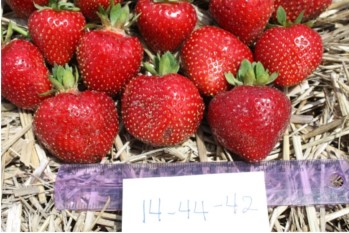Strawberry Hybridization
Brian Smith is a professor of Horticulture and State Extension Commercial Fruit Specialist at the University of Wisconsin-River Falls. He teaches advanced fruit and vegetable production courses & Intro to Plant Science at UWRF and works with commercial fruit growers across the state to improve their profitability. Dr. Smith is also director of a 28-acre Fruit TREE (Teaching, Research & Extension Education) facility on campus and conducts research resulting in the creation of new strawberry, grape, plum, apricot and cherry cultivars. He has grown many crops commercially in South Dakota, including strawberries, watermelons, greenhouse crops and Christmas trees. Here is a report on his latest research on hybrids.
Wisconsin’s relatively large fruit industry was a huge draw 30 years ago to start a fruit breeding program (Strawberries-1988, Stone Fruit-1991, Dessert Grapes-2012, Raspberries 1993 & Aronia- 2012) even though it would have to start from scratch and continue and expand with no permanent funding. Wild germplasm use and interspecific hybridization have been the primary tools to incorporate winter hardiness. All crosses are made on potted plants in the greenhouse and resulting seedlings transplanted to the field for maturation and later evaluation and selection (1-16 years later when they fruit for the first time).

Much of the strawberry research activity over the past three winters and springs have revolved around hybridization. Using unique parental combinations and the propagation of advanced selections, we attempted to generate sufficient plants for establishing three replicated performance trials in Summers 2017, 2018 and 2019.
These replicated performance trials serve multiple purposes. First, we grow new cultivars from all over the world for adaptation and commercial feasibility for Wisconsin and the Upper Midwest. Second, we also test breeding selections from other programs. Last, the trials serve as the first formal screenings of the best selections from the UW-RF breeding program.
In 2017, we established a 4-replicate randomized complete block performance trial with 42 entries. Fourteen cultivars were established and included the industry “check” cultivars of Annapolis, Wendy, Honeoye, Cavendish, Jewel and Valley Sunset. Other newer, cultivars also established were Archer, Daroyal, Flavorfest, Lila, Galletta, Malwina, Rutger’s Scarlet, Sonata and Yambu. The University of Wisconsin-River Falls Strawberry Breeding Program was the source for advanced selections also in the trial and included 06-45-5, 09-7-20-1, 09-49-2, 10-80-5, 13-85-27, 13-92-15, 13-92-94 and 14-36-4. The three numbers in these selection identifiers are: Year selection was made-numerical code for parental combination of that selection-seedling number of that progeny in the field map.

In Summer 2018, we established a 3-replicate performance trial to test multiple UWRF selections, 3 University of Minnesota selections, one Cornell University selection, and several newer cultivars released from other worldwide programs. The standard “check” cultivars were Wendy, Annapolis, Honeoye, Cavendish, Jewel and Valley Sunset. New entrants were NY02-56 (Cornell University) MNUS 796, MNUS 691, MNUS 1269 (Minnesota selections) and the rest were all from the UWRF program: RF 02-3-4, RF10-12-29, RF 10-72-42, RF 10-75-50, RF 11-25-12, RF 11-28-28, RF 13-73-4, RF 13-77-2, RF13-85-27, RF 13-88-1, RF 13-92-94, RF 14-44-42, RF 14-51-35, RF 14-65-3, RF 14-101-11, RF 16-31-34, RF 16-31-39, RF 16-35-13.
In June 2019, we established a third 4-replicate trial that consisted of the cultivars Archer, Lila, Cavendish, Flavorfest, Honeoye, Jewel, Rutger’s Scarlet, Valley Sunset, Yambu and Wendy and the remaining all UWRF selections: 02-3-4, 02-14-25, 06-66-43, 09-7-9-17, 10-3-34, 10-12-29, 13-75-6, 13-77-2, 13-85-27, 13-92-92, 13-92-94, 14-36-4, 15-12-23, 15-15-15, 15-25-2, 15-25-26, 15-29-24, 15-29-77.
Our new cultivar goals include:
- Frost tolerance either by plant architecture or actual bio-tolerance
- Improved consumer acceptance
- Size > 13g for harvest season
- Firmness- > Cabot (skin and flesh)
- Flavor – target of Earliglow & Jewel
- Appearance – glossy, medium red; uniformity; fancy calyx
- Higher yields than current big three: Honeoye, Cavendish, Jewel
- Improved winter tolerance–to not only severe minimum but to fluctuating (global warming effects)
- Pest tolerance or resistance
- Fewer pesticide applications
- Higher prices for organic
Priorities for Traits: Winter Hardiness
- Sufficiently short maturity season allows time for plant to acclimate in fall
- Tolerance to mid-winter cold
- Tolerance to fluctuating temperatures
There have been 88,009 seedlings planted over the years, with 86,569 selected from. Approximately 2,288 seedlings were established in 2017 for evaluation in Summer 2018. Out of these seedlings, 15 selections were made in Summer 2018. In Summer 2019, we established 1,440 seedlings (poor germination) representing 65 parental combinations (progenies) to be evaluated in Summer 2020.
The Best Recent Selections are summarized as follows:
- 15-29-24 (Cabot x RF 02-3-4) Large, firm, glossy berries; very productive and excellent flavor
- 15-29-77 (Same parents as above) Very large and even more productive than its sibling; excellent flavor and vigor
- 15-51-7 (Canadian cv. X RF 02-3-4) Extreme vigor and health; very productive; glossy bright red globe with a mild flavor
- 16-23-18 (RF 13-14-29 x European cv.) Huge fruit; very late and very firm
- 16-31-34 (Cavendish x RF 02-3-4) Very large and very productive; firm red conic; good flavor
- 13-77-2 (Canadian cv. x RF 02-3-4) Midseason late; firm glossy, globe with meaty texture and very good, sweet flavor; very productive
- 13-85-27 (Canadian sel. x Mn sel.) Very late and very productive; firm, with excellent flavor; healthy plants
- 13-92-94 (Eastern cv. x RF 02-3-4) Mid-late with very good flavor; holds fruit off ground; easy picking; few fruit rots
- 14-34-35 (RF 04-56-54 x RF 05-50-30) Very vigorous and no leaf diseases; dark red glossy fruit with very good flavor; pronounced neck
- 14-44-42 (RF 10-69-5 x European cv.) Deep, glossy, red firm fruit; moderate vigor and very good flavor
- 14-65-3(Canadian cv. X RF 04-55-3) Amazing vigor and dark, red glossy firm fruit with great flavor
- 15-25-26- (RF 11-28-34 x RF 10-71-73) Extreme vigor; excellent flavor; holds fruit upright; good yield in bad year


